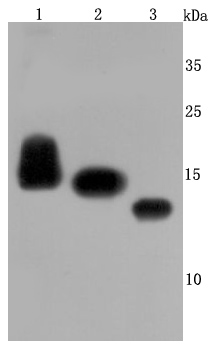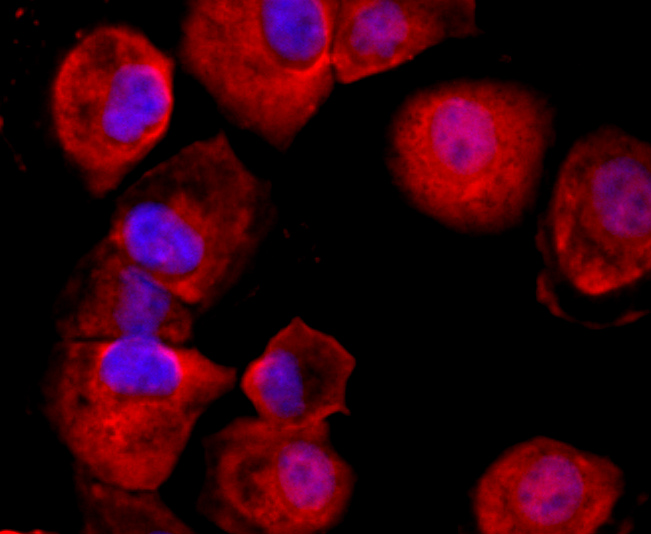Product Name :
CD59 polyclonal antibody Background :
CD59 is a GPI-anchored glycoprotein that is expressed on leukocytes, vascular endothelial cells, various epithelial cells and placenta. CD59 acts together with CD58 in mediating T cell adhesion and activation, and it may be a second ligand of CD2. CD59 functions as a regulator of the terminal pathway of complement by binding to the C8/C9 components of the assembling membrane attack complex (MAC) on host cell membranes, to stop the formation of the lytic pore. CD59 also drives both calcium release and activation of lipid-raft associated signalling molecules such as tyrosine kinases. CD59 gene has two p53-responsive domains that may be implicated in the defense of host cells from damage by the complement system in inflammation, suggesting that p53 could be used to mediate susceptibility of tumor cells to the complement lysis during chemotherapy. Product :
Rabbit IgG, 1mg/ml in PBS with 0.02% sodium azide, 50% glycerol, pH7.2 Storage&Stability :
Store at +4°C after thawing. Aliquot store at -20°C or -80°C. Avoid repeated freeze / thaw cycles. Specificity :
CD59 polyclonal antibody detects endogenous levels of CD59 protein. Immunogen :
recombinant protein Conjugate :
Unconjugated Modification :
Unmodification
CD59 polyclonal antibody Background :
CD59 is a GPI-anchored glycoprotein that is expressed on leukocytes, vascular endothelial cells, various epithelial cells and placenta. CD59 acts together with CD58 in mediating T cell adhesion and activation, and it may be a second ligand of CD2. CD59 functions as a regulator of the terminal pathway of complement by binding to the C8/C9 components of the assembling membrane attack complex (MAC) on host cell membranes, to stop the formation of the lytic pore. CD59 also drives both calcium release and activation of lipid-raft associated signalling molecules such as tyrosine kinases. CD59 gene has two p53-responsive domains that may be implicated in the defense of host cells from damage by the complement system in inflammation, suggesting that p53 could be used to mediate susceptibility of tumor cells to the complement lysis during chemotherapy. Product :
Rabbit IgG, 1mg/ml in PBS with 0.02% sodium azide, 50% glycerol, pH7.2 Storage&Stability :
Store at +4°C after thawing. Aliquot store at -20°C or -80°C. Avoid repeated freeze / thaw cycles. Specificity :
CD59 polyclonal antibody detects endogenous levels of CD59 protein. Immunogen :
recombinant protein Conjugate :
Unconjugated Modification :
Unmodification
-
 Western blot analysis of CD59 on different cells lysates using anti-CD59 antibody at 1/500 dilution. Positive control: Lane 1: Human placenta Lane 2: HUVEC Lane 3: K562
Western blot analysis of CD59 on different cells lysates using anti-CD59 antibody at 1/500 dilution. Positive control: Lane 1: Human placenta Lane 2: HUVEC Lane 3: K562 -
 ICC staining CD59 in HUVEC cells (red). The nuclear counter stain is DAPI (blue). Cells were fixed in paraformaldehyde, permeabilised with 0.25% Triton X100/PBS.
ICC staining CD59 in HUVEC cells (red). The nuclear counter stain is DAPI (blue). Cells were fixed in paraformaldehyde, permeabilised with 0.25% Triton X100/PBS.
Bioworld Biotech only provide peptides for our antibodies and do not provide additional peptide customization services.
Price/Size :
USD 368/1mg/vial
Tips:
For phospho antibody, we provide phospho peptide(0.5mg) and non-phospho peptide(0.5mg).Describe :
Blocking peptides are peptides that bind specifically to the target antibody and block antibody binding. These peptide usually contains the epitope recognized by the antibody. Antibodies bound to the blocking peptide no longer bind to the epitope on the target protein. This mechanism is useful when non-specific binding is an issue, for example, in Western blotting (WB) and Immunohistochemistry (IHC). By comparing the staining from the blocked antibody versus the antibody alone, one can see which staining is specific; Specific binding will be absent from the western blot or IHC performed with the neutralized antibody.Formula:
Synthetic peptide was lyophilized with 100% acetonitrile and is supplied as a powder. Reconstitute with 0.1 ml DI water for a final concentration of 10 mg/ml.The purity is >90%,tested by HPLC and MS.
Storage:
The freeze-dried powder is more stable. For short time at 2-8°C. For long term storage store at -20°C.
Note :
This product is for research use only (RUO only). Not for use in diagnostic or therapeutic procedures.
 CD59 polyclonal antibody
CD59 polyclonal antibody  Datasheet
Datasheet COA
COA MSDS
MSDS SHIP
SHIP